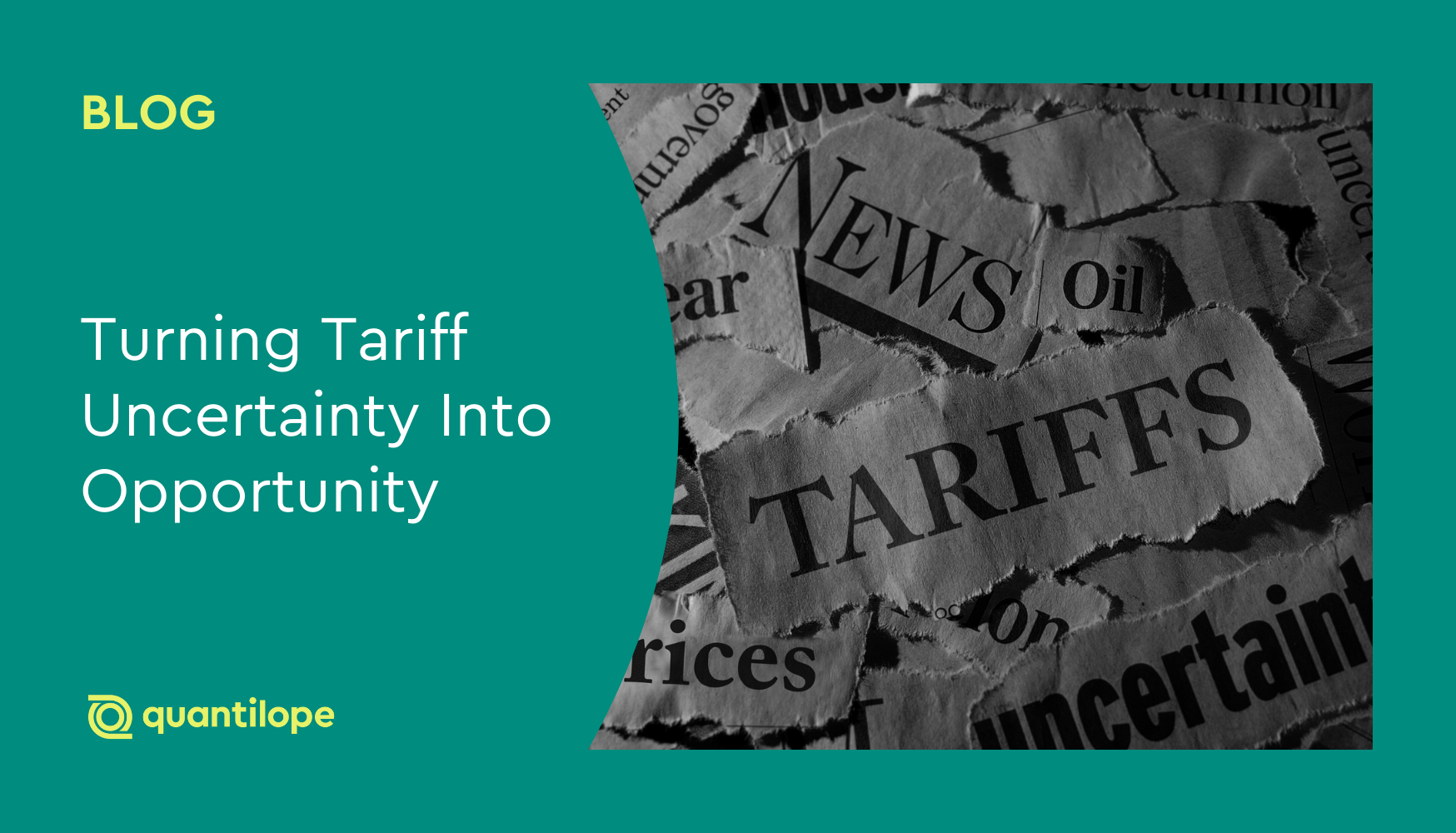Recent shake ups around tariffs have made the global trade arena near impossible to predict. From new tariffs, to tariff pauses, trade disputes, and other volatility, now more than ever businesses need to stay vigilant in understanding their consumers and responding to their needs.
Think about it: the changing tariffs and information around them have already started to disrupt global supplies, impact prices, and cause businesses to change their normal operations. For brands to remain competitive and lucrative, their ability to anticipate needs and adapt accordingly becomes paramount. However, many brands may not even know where to start when it comes to understanding tariffs and what they'll mean for their business - directly or indirectly. This is where automated consumer intelligence comes into play, as more than a ‘nice-to-have’. Consumer insights are now a non-negotiable for businesses to confidently act on strategic initiatives and defend their success. Automated research allows brands to get real-time, valuable insights much faster (and of the same or better quality) than they’d get with a traditional market research approach. In a time where everything is so unpredictable, having valid consumer insights is one less thing you're left guessing on.
Regardless of what ends up happening with tariffs in the future, understanding how consumers are reacting to the current climate and anticipating their future behavior allows businesses to make informed decisions that safeguard their bottom line – and might even uncover new growth opportunities.
Consumer sentiment & price sensitivity
Some brands may anticipate the immediate impact tariffs will have on their business, though most will probably be left feeling completely in the dark. Even if tariffs don’t directly affect a business's goods and services, will consumers be shopping less overall? Will they have less discretionary income given the rise in costs of goods they can’t forgo?
When you start to consider these cascading impacts of tariffs, they become a topic businesses simply can’t choose to ignore if they want to stay competitive. That’s where market research comes in as a valuable tool to stay ahead and gain clarity despite the unknowns.
Consider the automotive industry. Tariffs on imported steel and aluminum directly impact manufacturing costs, potentially leading to higher sticker prices. In response, will consumers delay vehicle purchases, opt for used vehicles, or shift their preferences to domestic brands? As another example, consider the apparel sector where tariffs on textiles will influence the price of clothing for manufacturers and retailers across the globe. Will consumers absorb these costs, trade down to lower-priced retailers, or reduce their overall spending on fashion? Even as a non-fashion retailer, this is something to pay attention to, as consumers may reduce their spending on other product categories to offset their increased spending on clothing.
Market research will be a key asset in navigating these tariff uncertainties and consumers’ behavioral outcomes – such as changes in brand loyalty or purchase frequency. Using market research studies to capture point-in-time metrics (ad-hoc studies), or to track ongoing shifts in consumer sentiment (tracking studies), will arm brands with the strategic insights they need to keep their brand(s) strong and healthy. Advanced methods like Choice-Based Conjoint (CBC) or Price Sensitivity Meter (PSM) take studies a step further to pinpoint exact product offerings or price points that will influence consumer decisions and sentiments.
Strategic use of advanced consumer insights
To make the most of your consumer insights, choose a focus for your study that will best answer your business uncertainties. Below are a few ways brands can leverage advanced consumer insights to navigate the changing market landscape with respect to tariffs.
Pricing strategies informed by consumer intelligence
When it comes to retail pricing, the last thing you want to do is guess what consumers will pay for your products and services. Brands can leverage pricing research like a Van Westendorp Price Sensitivity Meter (PSM) to test and identify specific price ranges and even an optimal price point to charge for their goods. With a pricing research study, brands can even simulate different tariff scenario price points to see if consumers consider those prices ‘too expensive’ – to the point where they wouldn’t consider buying the product/service. PSMs and other pricing method studies help brands find the right balance between profitability and consumer acceptance/willingness to pay. Brands can also leverage pricing research to understand how to price loyalty programs or promotional sales.
Pricing market research also helps brands understand consumer compromises with regards to their product offerings. For example, are consumers willing to wait longer for a product sourced from a specific region if it means a lower price, or, do they prioritize consistent pricing over faster delivery times? Using a Choice-based Conjoint analysis, brands can determine how important price is over elements like delivery speed, packaging type, product origin, etc.
No two consumers will ever be the same, even within the same target audience. This means willingness to spend can vary within a brand's overall consumer base. A Segmentation study helps brands uncover these varying consumer segments to identify and predict how each will respond to price changes. If the brand has a particularly price sensitive segment, they may want to change their communication tactic for this group amidst tariff-driven price increases, or, focus on their less price sensitive segments while they come up with new strategies and tactics. Understanding price elasticity within different segments enables businesses to make informed pricing decisions, potentially absorbing some tariff costs for more price-sensitive groups while passing them on to others that are still willing to pay.
Product portfolio optimization during rising cost pressures
With rising costs, brands might have to choose a subset of their products to focus on and optimize (rather than trying to juggle them all). A product portfolio study can help brands identify which products have the most potential in the market due to price elasticity or consumer preference. Brands interested in optimizing their product portfolio in attempts to safeguard against unexpected tariff pressures can leverage a MaxDiff or TURF analysis. A MaxDiff analysis will help brands identify which features consumers find most important through forced tradeoff decisions. Knowing the relative importance of features helps brands prioritize products/services that offer those benefits (or work on optimizing existing products so that they do).
Another way to optimize your offerings is through a TURF analysis (Total Unduplicated Reach and Frequency) which helps brands avoid duplicating their efforts. Sometimes, brands offer two products that end up reaching the same set of consumers (i.e. removing one of these products won’t likely cause a decline in overall brand consumption). With TURF as a way to highlight what those duplicate efforts are, brands can cut back on their product lines without compromising their consumer reach. In light of tariffs, this is one way businesses can save resources, or, use the TURF insights to discover new product opportunities that will reach a whole new set of consumers and strengthen their overall brand reach.
Marketing message refinement for anxious consumers
Acknowledging the economic uncertainty is a great way to build trust and credibility among your customers. But what is it that you’ll say?
Test your marketing messages with a MaxDiff analysis or A/B Testing framework to determine the most important claims to include in your messaging, and to understand which overall version of your communication tactic resonates best (respectively). For brands facing unavoidable price increases due to tariffs, transparent communication and assurance will signal to customers that despite the volatility of the market, they’re still getting a product they know and trust.
A TURF analysis is also helpful for brands when it comes to messaging strategy, to determine which channels are the most effective at communicating their product information. Given the rise in the cost of goods, being able to strategically allocate budget to the right marketing channels will help effectively allocate remaining resources.
Navigating tariffs with quantilope’s Consumer Intelligence Platform
Amidst the unpredictability that tariffs will have on the market, relying on slow or outdated research won’t allow brands to remain competitive. quantilope’s automated Consumer Intelligence Platform helps brands capture real-time insights into their current or prospective customers with the largest suite of advanced methods and an integrated AI co-pilot.
With quantilope, brands can run fast, custom research studies using advanced methodologies – even with zero background in market research or any understanding of behavioral science. quantilope’s questionnaire setup uses drag & drop modules so users can easily drop in any pre-programmed questions or methods with built-in logic and guardrails. For any questions or uncertainties, platform users can lean on their dedicated quantilope research team or quantilope’s integrated AI co-pilot, quinn. quinn can answer specific research questions, suggest survey inputs, and generate key takeaways all with a single chat-based prompt – as simple or detailed as a user decides to be.
Below are a few ways an individual or team might leverage quantilope’s platform to understand and navigate the impact of rising tariffs.
- Understanding price sensitivity: Perhaps the most obvious way to measure the impact of tariffs is to measure consumers’ sensitivities to changing prices. quantilope’s method library includes Van Westendorp's Price Sensitivity Meter (PSM) to identify acceptable price ranges and points of marginal cheapness/expensiveness. As mentioned above, brands can use this method to simulate different tariff pricing scenarios and predict how much those rises in costs will impact consumer demand for their products/services.
- Testing new or existing concepts: quantilope's agile concept testing capabilities allow brands to quickly iterate on different value propositions, pricing structures, or product variations in response to evolving tariff scenarios. With an A/B test or Choice-based Conjoint, brands get real-time feedback to refine their product offerings with the elements consumers care most about.
- Uncovering hidden biases: It’s one thing to know what consumers say, and another to know what they actually do. Tariffs can trigger unintended biases; consumers might not even know that they have an underlying preference toward one brand or another until forced to choose because of an external force like rising prices. An Implicit Association Test (IAT) captures these kinds of subconscious associations consumers have toward brands or categories with regard to elements like price, product origin, and value. For example, are consumers subconsciously associating imported goods with lower quality due to tariff-related price hikes? Single Implicit Association Tests (SIATs) measure these associations for one brand, product, or category while Multi Implicit Association Tests (MIATs) measure these subconscious associations for multiple brands, products, or categories.
The above scenarios are just three examples of how brands can leverage any of quantilope’s 15 automated, advanced methodologies for rich, complex insights to navigate uncertain markets. With consumer insights at your fingertips on quantilope’s platform, the shadow of tariff uncertainty doesn't have to imply doom for your business. By embracing the power of consumer intelligence and understanding consumers on a granular level, you can turn external challenges into significant opportunities for competitive differentiation and long-term growth. You can use your insights to shift alongside the market, adapting pricing strategies and product features according to real-time consumer data.
By leveraging quantilope’s advanced methodologies and intuitive platform, brands gain the clarity and confidence they need to make informed decisions, optimize their offerings, and ultimately strengthen their relationship with customers to gain a competitive advantage.
To learn more about automated, advanced research with quantilope, get in touch below!




.png)
